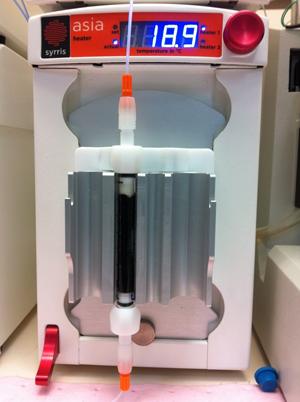Ruthenium catalyst goes with the flow

A ruthenium catalyst packed into a reaction column can help to produce a steady stream of useful products. © 2014 A*STAR Institute of Chemical and Engineering Sciences
An efficient catalyst has opened up an environmentally benign route to a family of molecular building blocks found in many pharmaceuticals and agrochemicals, a study shows.
Molecular building blocks known as substituted amines contain a nitrogen atom bonded to at least two carbon atoms. They are often made by reacting nitrogen-containing amines with carbon-based molecules bearing a halogen atom such as chlorine, but this process tends to produce significant amounts of toxic waste.
Cleaner synthesis processes use a catalyst to connect the carbon chain of an alcohol molecule to the amine. But these catalysts, which contain metals such as ruthenium and iridium, usually dissolve in solution with the reactants. This makes it difficult to separate them from the products once the reaction is completed, wasting precious catalyst and increasing processing costs.
Balamurugan Ramalingam and colleagues at the A*STAR Institute of Chemical and Engineering Sciences have now developed a ruthenium catalyst that does not dissolve in solution, potentially making this reaction greener and more efficient[1].
The team used linker molecules containing phosphorus atoms to attach the ruthenium compound [Ru(p-cymene)2Cl2]2 to tiny polystyrene beads or granules of silica. These particles are easily filtered from the reaction mixture.
The researchers optimized the catalyst’s activity by testing different types of linker and varying the amount of ruthenium compound on each particle. They then used the best catalyst to join together a wide range of amines and alcohols, producing various substituted amines in good yields. The catalyst could be recycled over five reactions without much loss in activity, and very little ruthenium leached from the solid particles into solution. Ramalingam’s team then exploited the catalyst to produce a drug molecule called piribedil (used to treat Parkinson’s disease) in almost 100 per cent yield.
The catalyst beads can also be packed into hollow columns (see image) so that reagents flow over them to deliver a stream of products. Such continuous-flow systems are increasingly used to make pharmaceuticals or other high-value chemicals, as a more efficient and sustainable alternative to conventional ‘batch-by-batch’ processes.
The scientists slowly pumped an amine and an alcohol through the loaded column at a temperature of 120 °C. This delivered a continuous flow of product in 60–70 per cent yields for 21 hours, with virtually no loss of ruthenium. “In principle, the reaction could be scaled up to production scale, and the complete conversion could be achieved by recycling the reagents,” says Ramalingam. The team is now using the catalyst to make amine-based polymers.
The A*STAR-affiliated researchers contributing to this research are from the Institute of Chemical and Engineering Sciences
Reference:
[1] Shan, S. P., Dang, T. T., Seayad, A. M. & Ramalingam, B. Reusable supported ruthenium catalysts for the alkylation of amines by using primary alcohols. ChemCatChem 6, 808–814 (2014).
Media Contact
More Information:
http://www.researchsea.comAll latest news from the category: Power and Electrical Engineering
This topic covers issues related to energy generation, conversion, transportation and consumption and how the industry is addressing the challenge of energy efficiency in general.
innovations-report provides in-depth and informative reports and articles on subjects ranging from wind energy, fuel cell technology, solar energy, geothermal energy, petroleum, gas, nuclear engineering, alternative energy and energy efficiency to fusion, hydrogen and superconductor technologies.
Newest articles

Security vulnerability in browser interface
… allows computer access via graphics card. Researchers at Graz University of Technology were successful with three different side-channel attacks on graphics cards via the WebGPU browser interface. The attacks…

A closer look at mechanochemistry
Ferdi Schüth and his team at the Max Planck Institut für Kohlenforschung in Mülheim/Germany have been studying the phenomena of mechanochemistry for several years. But what actually happens at the…

Severe Vulnerabilities Discovered in Software to Protect Internet Routing
A research team from the National Research Center for Applied Cybersecurity ATHENE led by Prof. Dr. Haya Schulmann has uncovered 18 vulnerabilities in crucial software components of Resource Public Key…





















